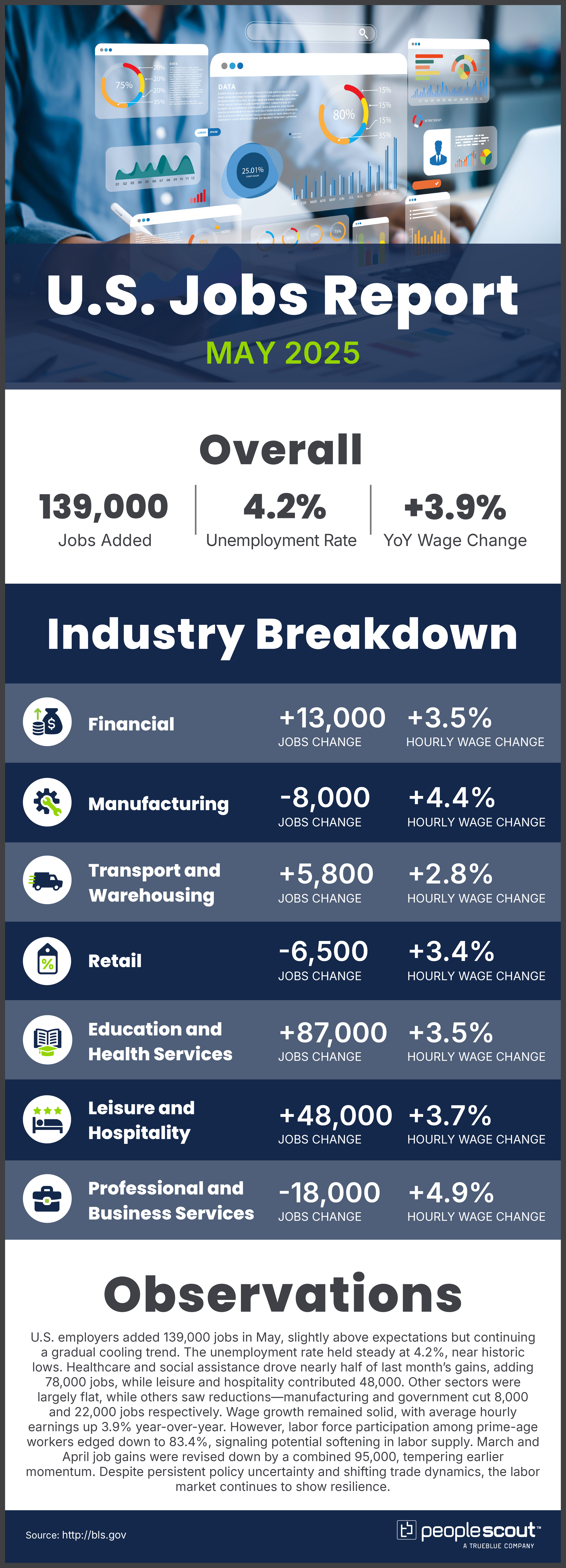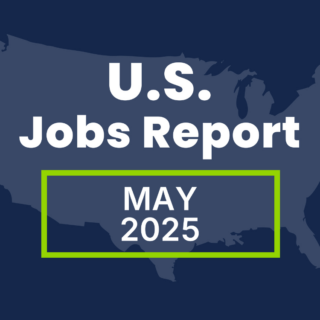U.S. employers added 139,000 jobs in May, slightly above expectations but continuing a gradual cooling trend. The unemployment rate held steady at 4.2%, near historic lows. Healthcare and social assistance drove nearly half of last month’s gains, adding 78,000 jobs, while leisure and hospitality contributed 48,000. Other sectors were largely flat, while others saw reductions—manufacturing and government cut 8,000 and 22,000 jobs respectively. Wage growth remained solid, with average hourly earnings up 3.9% year-over-year. However, labor force participation among prime-age workers edged down to 83.4%, signaling potential softening in labor supply. March and April job gains were revised down by a combined 95,000, tempering earlier momentum. Despite persistent policy uncertainty and shifting trade dynamics, the labor market continues to show resilience.

The Numbers
- 139,000: U.S. employers added 139,000 jobs in May.
- 4.2%: The unemployment rate remained at 4.2%.
- 3.9%: Wages rose 3.9% over the past year.
The Good
U.S. employers added 139,000 jobs in May, modestly surpassing expectations and reflecting continued resilience in the labor market. Healthcare and social assistance led the way, adding 78,000 new jobs, while leisure and hospitality added 48,000—both sectors outpacing their recent averages. The unemployment rate held steady at 4.2%, maintaining historically low levels. Wage growth remained solid, with average hourly earnings rising 3.9% year-over-year, suggesting ongoing demand for workers. Despite macroeconomic uncertainty, these steady gains point to businesses’ sustained need for talent to meet demand, even as growth moderates compared to prior years.
The Bad
Beneath the headline numbers, signs of softening emerged. Job creation was heavily concentrated in a few sectors, while industries like manufacturing shed 8,000 jobs and overall federal government employment declined by 22,000 positions. Labor force participation among prime-age workers (25–54) dipped to 83.4%, reversing some of the gains seen earlier this year and indicating possible hesitancy among workers. Revisions to March and April’s job numbers lowered previous estimates by a combined 95,000, tempering perceptions of earlier strength. Broader measures of employment, including the employment-to-population ratio and alternative unemployment metrics, also showed signs of weakening.
The Unknown
While May’s job growth exceeded forecasts, questions remain about the durability of the labor market’s momentum. The concentration of gains in healthcare—driven in part by demographic trends rather than broad-based economic expansion—raises concerns about the underlying strength of demand across industries. Trade uncertainties and shifting global economic conditions continue to weigh on business sentiment, causing uncertainty around future hiring plans. Meanwhile, the Federal Reserve faces the challenge of balancing inflation risks with signs of a gradually cooling labor market as it approaches its next policy meeting.
Conclusion
The May 2025 jobs report reflects a labor market that continues to show resilience, but with clear signals of deceleration beneath the surface. Solid wage growth and consistent hiring in key sectors provide reasons for cautious optimism. Yet, downward revisions to previous months’ job gains, imbalances across industries and the decline in labor force participation suggest growing headwinds. As organizations navigate an evolving economic landscape, strategic workforce planning and flexible talent strategies will be critical to sustaining momentum in an increasingly complex environment.



